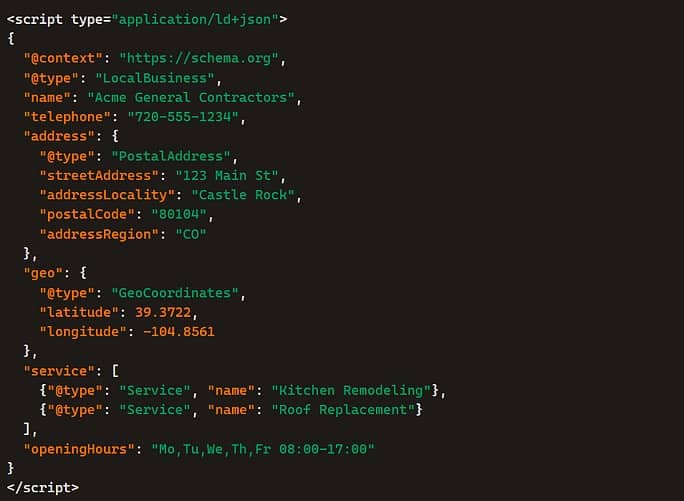table of contents
This guide is crafted for marketing leads, operations managers, and local sales teams at general contracting firms seeking tactical, repeatable SEO steps to capture high-intent, locally sourced leads. It explains how local search behavior, maps-first visibility, and targeted content drive calls, quote requests, and booked projects without requiring deep SEO expertise.
Local SEO for Contractors: Primary Keywords Target Examples
- general contractor near me
- local roofing contractor
- kitchen remodeling in [City]
- bathroom renovation zip code [XXXXX]
- home addition contractor [Neighborhood]
Use these as thematic anchors: place one in the meta title and H1 of pillar pages, distribute variations naturally across H2s and body copy, and reserve exact-match geo modifiers for service-area landing pages. Avoid stuffing; prioritize clear intent matching and genuinely helpful content.

Contractor SEO Concepts Explained
Contractor SEO is the strategic process of building a contracting business’s online presence to attract local customers and establish credibility. Think of it as planning and laying a foundation: optimizing your website, Google Business Profile, and other digital assets creates clear, strategic pathways that help search engines understand and rank your business for the keywords potential clients use.
Effective contractor SEO combines focused on-page content, precise keyword targeting, and consistent local citations to guide searchers to your services. When those elements work together, your site earns higher visibility, drives more qualified local traffic, and converts searches into calls and booked jobs—delivering a steady stream of prospects, better engagement, and measurable revenue growth for your contracting business.
Quick SEO checklist
Why Local SEO Matters for General Contractors
Business dynamics
- High-intent project inquiries. Local searches often signal immediate renovation, repair, or construction needs. Ranking in local packs drives phone calls and quote submissions, turning searchers into booked jobs.
- Seasonal and project-based demand. Kitchens, decks, and roofing spikes align with seasons and weather. Tailored neighborhood-focused pages capture these predictable surges and feed pipelines for lean months.
Understanding Local Businesses
For general contractors and other local businesses, a strong digital foundation is key to expanding reach and driving growth within their communities. Success starts with the essentials: a well-optimized Google Business Profile, a professionally built website, and a steady stream of positive reviews, all working together to build trust and credibility in local search results.
Navigating the competitive landscape means standing out among nearby contractors by offering clear, targeted solutions that speak directly to local needs. With smart SEO strategies, like optimizing for local search terms, earning high-quality backlinks, and creating content tailored to your audience, contractors can strengthen their reputation, increase visibility, and attract a consistent flow of qualified leads. It’s a practical, results-driven approach that turns online searches into real business growth.
Search behavior in 2025
- Natural, long-tail neighborhood queries. Homeowners ask “best roofing contractor zip code 80104” or “licensed general contractor near [Landmark].” Content that directly answers these prompts captures qualified prospects. Optimizing your content to match what people search for locally ensures your business appears in relevant local queries.
- Maps-first visibility. Google Maps and local packs dominate transactional local intent, driving click-to-call, directions, and “Request Quote” actions. A complete, optimized profile and service-area pages decide who shows at the top.
On-page Content and Keyword Strategy
Target keyword mapping
| Keyword | Search Intent | Best Page Type |
|---|---|---|
| general contractor near me | Transactional local intent | Service-area landing page |
| roofing contractor [City] | Transactional local intent | Service-area landing page |
| kitchen remodeling ideas | Informational; inspiration | Blog pillar or guide |
| bathroom renovation cost zip | Commercial research; pricing | Blog post with cost breakdown |
| home addition contractor | Transactional; project hire intent | Service page with lead form |
| licensed general contractor | Trust-building; compliance questions | FAQ or about us page |
| deck builder near me | Transactional local intent | Local landing page |
| remodeling contractors reviews | Informational; social proof | Review roundup blog post |
Identifying and tracking target keywords for each service area is essential to maximize local SEO impact and ensure your content aligns with user intent and ranking goals.
Keyword Research Tools
For contractors looking to grow their online presence and attract high-quality leads, keyword research is a critical first step. Tools like Google Keyword Planner and Semrush act as your digital base camp, offering valuable insights into the exact terms potential customers use when searching for services like yours. These platforms help you understand search volume, competition levels, and related phrases, giving you the data needed to build a focused, effective SEO strategy.
By thoughtfully incorporating these keywords into your website content, meta descriptions, and title tags, you improve your chances of ranking higher in search results and connecting with the right audience. Just as a skilled builder chooses the right materials for a strong foundation, using the right keywords ensures your site speaks directly to what your customers are looking for. The result? Increased visibility, stronger engagement, and a reputation as the go-to contractor in your market.
Keyword Rankings
In contractor SEO, keyword rankings act as your progress markers, showing exactly where your website stands in search results for the terms your potential customers are using. Just like tracking elevation on a climb, these rankings directly impact how much traffic your site receives, how many leads you generate, and how quickly those leads convert into sales.
Tools like Google Search Console and Semrush help you monitor your position, uncover new keyword opportunities, and adjust your strategy with precision. By regularly refining your website content, building strong backlinks, and improving user experience, you can steadily climb the search engine ladder. The higher you rank, the more visible and trusted your business becomes, leading to consistent growth and a stronger foothold in your local market.
Local landing pages and site architecture
- Authority pages: company profile, licenses, insurance details, and portfolio galleries, establishing E-E-A-T.
- Lead pages: local landing pages with click-to-call, “Request a Quote” form, FAQ, and trust signals such as recent neighborhood reviews and customer testimonials.
- Blog assets: how-tos, cost guides, seasonal project suggestions, case studies answering long-tail homeowner questions.
- On-page signals: clear H1s, descriptive H2s, schema markup, local phone in markup, and prominent CTAs.
Internal Links
Internal links play a key role in guiding both users and search engines through your website. Think of them as digital pathways that connect your most important content. For contractors, a smart internal linking strategy helps visitors move seamlessly between service pages, blog posts, and other key areas, making it easier for them to find what they need and take action.
Using clear, descriptive anchor text and linking to relevant pages not only improves user experience but also strengthens your site’s SEO. These links help distribute authority across your website, boosting your rankings and making your content more discoverable. When done right, internal linking turns casual visitors into qualified leads by leading them through a smooth, intuitive journey that highlights your expertise and services.
On-page optimization checklist
Technical and Local Setup
Google Business Profile and Maps
| GBP Field | Why It Matters |
|---|---|
| Name / NAP | Matches searcher expectations, prevents friction |
| Primary category | Determines local pack inclusion |
| Service areas | Targets zip-based and city-based queries |
| Booking URL | Direct path to quote forms |
| Photos | Builds trust and drives map-pack clicks |
Local schema and structured data
- Implement JSON-LD in the page header for LocalBusiness, PostalAddress, GeoCoordinates, Service, FAQ, and Offer.
- Include accepted payment methods and lead form URLs to clarify intent for crawlers.

Mobile UX checklist
Tracking and crawlability
- Configure GA4 events for call clicks, form submissions, and gallery view expands, and use Google Analytics to track website traffic and measure SEO performance.
- Use Google Search Console for index coverage, URL inspection, and performance by city or zip.
- Submit an XML sitemap including every local landing page.
- Maintain strong internal linking: blog posts → local pages using anchor text like “kitchen remodeler in 80104.”
- Audit quarterly to catch orphan pages and fix crawl errors.
Reputation, Citations, and Partnerships
Reviews strategy
- Post-project follow-up email/SMS within 24–48 hours with direct review links to GBP and a secondary site.
- One-click CTA plus prompt for details (project type, neighborhood, timeframe) to enrich local search relevance.
- Offer value-adds (priority scheduling, complimentary maintenance check) instead of cash incentives.
- Publicly respond to every review within 72 hours to showcase responsiveness.
A strong review strategy can help generate more leads by building trust and credibility.
Local citations and listings
- Claim directories: local Chamber of Commerce, HomeAdvisor, Angie’s List, neighborhood association websites.
- Centralize NAP control in a single spreadsheet or CMS module; audit quarterly for consistency.
- Prioritize listings indexed by maps and local search aggregators.
Building relationships and link partnerships
- Partner with local suppliers, hardware stores, architects, and interior designers for referral agreements and backlinks.
- Co-produce case studies on neighborhood renovations or sustainable build projects.
- Sponsor local events (block parties, home shows) to earn mentions on municipal and community domains.
- Log partnership outlets and backlink placements; focus outreach on domains serving the same zip code catchment.
Local SEO for contractors is essential for building authority and increasing visibility in local search results.
Measurement, Testing, and Scaling
KPIs and attribution
- Primary: phone calls, qualified leads, booked projects, revenue per campaign.
- Supporting: local impressions, map-pack rankings, GBP actions, and organic landing page conversions.
- Use unique tracking numbers or dynamic insertion to tie calls to origin pages.
- Record outcomes in CRM and import offline conversions for booked projects.
Experimentation
- Treat service-area pages as conversion labs. Test one variable at a time: CTA language, form length, phone placement, hero imagery.
- Run each test until statistical confidence on mobile traffic.
- Use session recordings and heatmaps to validate mobile drop-offs.
- Track micro-conversions (call clicks, form opens, gallery views) as leading indicators.
Scaling
Once a local template proves ROI, roll out to new zip codes using a three-part cadence:
- Pillar market page
- 3–5 cluster posts (project spotlights, cost guides, neighborhood events)
- Seasonal briefs tied to demand cycles (roofing season, kitchen updates before holidays)
- Automate routine updates (pricing tables, availability calendars) via data connectors; require editorial sign-off for all localized copy.
- Maintain a central rollout log of templates, tests, and ROI outcomes to refine future launches.
Post-publication and Editorial Plan
Promotion roadmap
- Short-term: GBP post linking to the new zip-specific page; targeted social ads to neighborhood audiences; email newsletter to past clients in that zip; small paid search test on “contractor [zip code].”
- Mid-term: outreach to hardware store partners for co-promotion; syndication on local community blogs; speaking slots at home shows or HOA meetings.
Maintenance and revision schedule
- Quarterly audit: update local event tie-ins, refresh FAQ schema, review performance metrics, and swap out outdated project photos.
- Evergreen tasks: convert high-performing blog posts into downloadable guides; update case studies with fresh client results.
- Flag seasonal briefs eight weeks before peak periods (spring deck builds, fall roof inspections).
Governance and content rules
- Tone: educational, data-driven, non-promotional.
- Keyword control: use blog for informational topics; reserve transactional terms on service-area pages.
- Quality checks: verify NAP consistency, factual accuracy, schema validity, and E-E-A-T signals (licenses, insurance, client testimonials).
Summary
This roadmap turns local search into a predictable channel for high-intent contractor leads by combining focused on-page tactics, disciplined measurement, and repeatable content operations. Start with one priority zip code, prove the model with measurable KPIs, and scale the playbook across your entire service territory.




